WHAT IS POLLUTING THE AIR IN YOUR HOME OR WORKPLACE?
Have you ever taken a deep breath while visiting an ocean or mountain? Our lungs appreciate the clean, unpolluted air that these natural settings offer. Now, have you ever taken that same type of deep breath when you enter your home or workplace? It is probably fair to say that most of us have not because these places do not provide the fresh air that we find in natural settings.
Indoor air quality (IAQ) refers to the quality of the air in an indoor environment like a home, office, or school.

Because as much as 90% of our time is spent indoors, improving indoor air quality is crucial for our health and well-being. For years, indoor air quality has been a leading health concern. In today’s current environment, that concern is even greater.
THREE COMPONENTS OF POOR INDOOR AIR QUALITY
In order to improve indoor air quality, one must first understand what is affecting it. Indoor concentrations of some pollutants are often two to five times higher than outdoor concentrations[1]. An individual pollutant may not pose a health risk, but unfortunately, most indoor environments have multiple pollutants affecting the air quality. Particulates, microbial organisms, and chemical pollutants are three components of poor indoor air quality that are worth examining further.
Particulates are very small solid or liquid substances, such as inorganic / organic compounds and dormant / living organisms, that are light enough to float in air. These include dust, dirt, pollen, pet dander, smoke, and liquid droplets to name a few. Both natural and human activity attribute to the particles in the air.
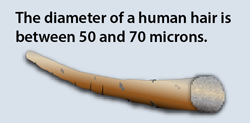
Particulates are classified on the basis of size, ranging from coarse particles between 10 and 2.5 microns to fine particles smaller than 2.5 microns. Health problems can occur when particulates contain solid or liquid droplets that are small enough to inhale. Once inhaled, particles can affect the heart and lungs. Particulates that are less than 10 microns in diameter can get deep into the lungs and sometimes into the bloodstream. Fine particulates that are less than 2.5 microns in diameter pose the greatest health risk.
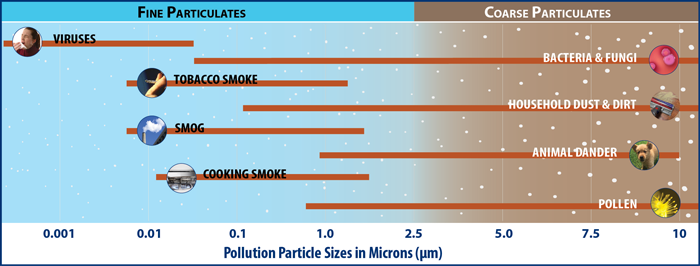
Microbial organisms represent germs, viruses, and bacteria. These microscopic organisms are present in every environment. As an important component of our ecosystem, microbial organisms contribute to the cycle of life and break down dead materials into constituent components. However, when these organisms are left uncontrolled inside buildings, they negatively affect indoor air quality and cause structural damage.
Moisture on indoor surfaces leads to growth of microbes like bacteria, fungi and mold. The growth of these microbes leads to organic compounds that are released into the air. Airborne mold spores are a common cause of asthma and allergy issues.
Occupants often bring viruses and bacteria into a home, school or workplace. One way to help control the spread of these viruses and bacteria is through effective ventilation. When the air in these places is stagnant, the probability of a disease spreading increases. Ventilation can affect how viruses and bacteria spread indoors.
Chemical (Gaseous) pollutants consist of carbon dioxide, tobacco smoke, ozone, and volatile organic compounds (VOCs) to name a few. Hundreds of gaseous pollutants have been detected in indoor environments. Health effects vary widely and depend on the types and concentration of pollutant, as well as the frequency and duration of exposure.
Since the 1940s, VOCs have become common by-products in residential and commercial goods. Everyday products often include organic chemicals in their ingredients. These ingredients become volatile organic compounds when the organic chemicals vaporize and become gases at room temperature. VOCs have a high vapor pressure and low water solubility. There are thousands of products that emit VOCs. VOCs are present in personal care products, cleaning products, furniture, and building materials. These products give off gases that, at high levels, can have adverse effects on one’s health.
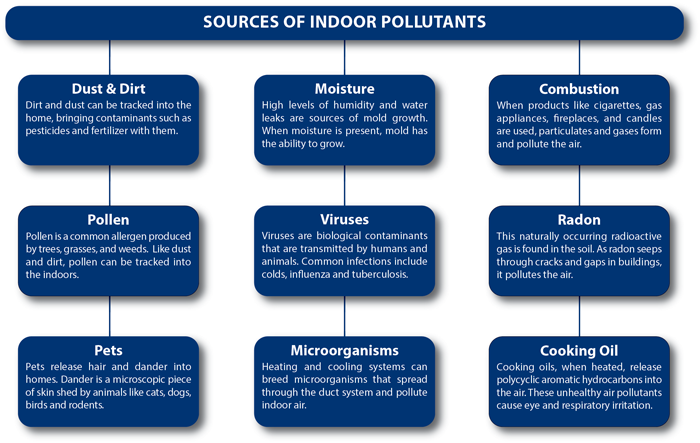
STEPS TO IMPROVE IAQ
Poor indoor air quality can adversely affect our health in a variety of ways. While a pollutant may trigger an immediate and mild reaction like a skin irritation or a headache in one person, it may have a long-term effect that leads to a severe illness like cancer or heart disease in another. Whether it is an acute or chronic disease, it is imperative that measures are taken to improve indoor air quality.
The energy crisis in the 1970s started the movement to airtight construction in homes and buildings. While this change led to improved energy efficiency, it contributed to an unhealthy indoor environment. However, there are steps that allow us to improve IAQ:
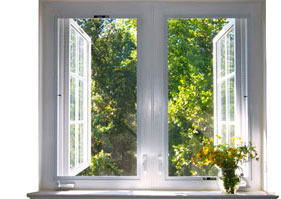
- Source Control
- Improved Ventilation
- Air Purification
Source Control
Some pollutants can easily be controlled at the source. For example:
- Choose green products when building and decorating a home or office.
- Use cleaning products with lower VOC content when cleaning a home or office.
- Repair leaks and water damage to prevent mold and mildew from growing indoors.
- Open windows or doors when participating in activities that use products with VOCs.
- Don’t smoke indoors or idle a car in an attached garage.
Improved Ventilation
When outdoor air is brought indoors, it promotes good indoor air quality. There are three ways to improve ventilation:
- Infiltration is a natural way in which air leaks through crack, joints and openings in a building. Infiltration is more common in homes and buildings that are older but is less likely to occur when a structure is newer or remodeled.
- Natural ventilation takes place when doors and windows are opened so that air can enter.
- Mechanical ventilation occurs when devices exchange outdoor and indoor air.
Residential and commercial dwellings need ventilation to reduce and control excess moisture, humidity and indoor air pollutants. The amount of time required for the air in a room to be completely exchanged is known as the air change rate. Pollutants can accumulate to unhealthy levels when the air change rate is too low due to a lack of infiltration, natural ventilation, or mechanical ventilation. Oftentimes, mechanical ventilation is required to expel the concentrations of indoor air pollutants and to bring in fresh air from the outdoors.
Distinct settings require different types of mechanical ventilation
Whole-house ventilation provides continuous ventilation to a dwelling. According to the EPA, most home heating and cooling systems, including forced air heating systems, do not mechanically bring fresh air into the home[2].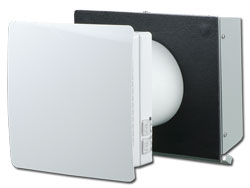 Today’s energy-efficient homes are installing HRVs and ERVs for improved ventilation. An HRV (heat recovery ventilator) is designed to supply fresh air to a home and to extract stale air from a home. An ERV (energy recovery ventilator) does everything that an HRV does but with the added benefit of humidity control. Regional climate is the deciding factor whether an HRV or ERV will be more effective.
Today’s energy-efficient homes are installing HRVs and ERVs for improved ventilation. An HRV (heat recovery ventilator) is designed to supply fresh air to a home and to extract stale air from a home. An ERV (energy recovery ventilator) does everything that an HRV does but with the added benefit of humidity control. Regional climate is the deciding factor whether an HRV or ERV will be more effective.
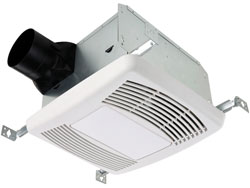 Spot ventilation is intermittent ventilation that is applied to a single room. A bathroom ventilation fan is a form of spot ventilation that mitigates excess moisture during use of a bathroom. Similarly, a range hood exhaust fan controls cooking fumes and odors when a stove is in operation. If necessary, a ceiling or wall exhaust fan can be added to help remove fumes and odors. A radon fan is another form of spot ventilation that helps to remove radon gas, which is the second leading cause of lung cancer according to the American Lung Association[3]. Exhaust fans should never vent into attics or crawl spaces because the moisture can cause structural damage over time. These devices should always vent through the space and into the outdoors.
Spot ventilation is intermittent ventilation that is applied to a single room. A bathroom ventilation fan is a form of spot ventilation that mitigates excess moisture during use of a bathroom. Similarly, a range hood exhaust fan controls cooking fumes and odors when a stove is in operation. If necessary, a ceiling or wall exhaust fan can be added to help remove fumes and odors. A radon fan is another form of spot ventilation that helps to remove radon gas, which is the second leading cause of lung cancer according to the American Lung Association[3]. Exhaust fans should never vent into attics or crawl spaces because the moisture can cause structural damage over time. These devices should always vent through the space and into the outdoors.
Air Purification
 Air purification is another approach to improving indoor air quality. Oftentimes, a person with asthma and allergies finds air purification helpful in alleviating symptoms. There are a variety of ways to purify indoor air, ranging from filtration to ultraviolet germicidal irradiation (UVGI). The impact on indoor pollutants is dependent upon the method of purification that is used. Let’s take a closer look at the different ways of managing indoor air pollutants with air purification.
Air purification is another approach to improving indoor air quality. Oftentimes, a person with asthma and allergies finds air purification helpful in alleviating symptoms. There are a variety of ways to purify indoor air, ranging from filtration to ultraviolet germicidal irradiation (UVGI). The impact on indoor pollutants is dependent upon the method of purification that is used. Let’s take a closer look at the different ways of managing indoor air pollutants with air purification.
Before looking at the different types of air purifiers, let’s provide a simple definition. An air purifier is a device designed to cleanse the air in a home or workplace. Some air purifiers are portable while others are incorporated into an HVAC system. Some air purifiers utilize filtration while others use UVC light and some incorporate both. It is important to understand the different methods of air purification:
- Air filtration
- Ultraviolet light
- Photocatalytic oxidation (POC)
Air Filtration
 One of the three components of poor indoor air quality is particulate matter. An air filter can physically trap these airborne particles and prevent them from recirculating or spreading. That is why most air purifiers and HVAC systems incorporate some type of air filter into their systems. The most common air filtration ratings are MERV and HEPA.
One of the three components of poor indoor air quality is particulate matter. An air filter can physically trap these airborne particles and prevent them from recirculating or spreading. That is why most air purifiers and HVAC systems incorporate some type of air filter into their systems. The most common air filtration ratings are MERV and HEPA.
MERV is a rating methodology that stands for Minimum Efficiency Reporting Value. The MERV rating, which ranges from 1 to 16, is an effectiveness scale that represents the expected performance of a filter. The MERV rating measures the filters ability to trap particles from 0.3 to 10 microns in size. For example, a MERV 16 filter is capable of trapping particles as small as 0.3 microns whereas a MERV 11 filter is designed to trap particles between 1–3 microns. The higher MERV rating indicates a higher efficiency for trapping smaller particles.
HEPA is a type of filter that stands for High Efficiency Particulate Air. It is a designation used to describe filters that trap at least 99.97% of particles that are 0.3 microns in size or larger.
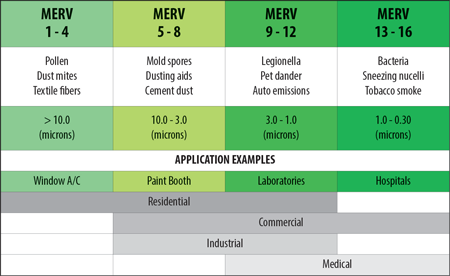 In order for filters to be effective, a high degree of air circulation is required. A filter cannot remove particles in the air unless the particles pass through the filter. The pressure drop through a filter must be accounted for when selecting a fan.
In order for filters to be effective, a high degree of air circulation is required. A filter cannot remove particles in the air unless the particles pass through the filter. The pressure drop through a filter must be accounted for when selecting a fan.
Ultraviolet Light
For years, ultraviolet (UV) light has been used in food processing, water purifying and medical equipment sterilizing. Today, the HVAC industry is utilizing UV light to improve indoor air quality.
Ultraviolet light is a type of electromagnetic radiation, transmitted by the sun in waves at different frequencies. The wavelength is measured in nanometers (nm) as follows:
- UVA 315 – 400 nm
- UVB 280 – 315 nm
- UVC 200 – 280 nm
In order to kill microbial organisms like viruses, bacteria and fungi, an air purifier needs to utilize UVC light. In this process, a UVC lamp, also known as a germicidal lamp, uses UVC radiation to damage an organism’s DNA. To be effective, the airborne microbes must pass through the treatment zone of the germicidal lamp. It is important to note that not all air purifiers utilize a UVC light. An air purifier without UVC light only traps airborne particulates. It is not designed to kill viruses or bacteria.
Maintenance is a key element in air purification. A UVC bulb loses its effectiveness over time. Filters cannot function properly if they are clogged with particles like dust and dirt. Without regular maintenance, which means following the manufacturers’ recommendations, an air purifier will not remain effective.
Photocatalytic Oxidation (PCO)
Photocatalytic oxidation, also known as PCO, is a reaction that occurs when Titanium Dioxide (TiO2) is exposed to ultraviolet (UVC) light. This process converts harmful and toxic compounds into benign constituents, such as water and carbon dioxide. To put it simply, this process takes toxins and chemicals from an airstream and chemically alters them into non-toxic compounds. When an air purifier incorporates the photocatalytic oxidation process, it cleanses the air of volatile organic compounds (VOCs) that cleaning products, paint, pesticides and other everyday products produce.

Each method of air purification provides a different approach to combating the various components of poor indoor air quality. Users who want to combat microbial organisms, like viruses and bacteria, will benefit from air purifiers that use UVC light. Users who want to combat particulates, like pollen, dust, and pet dander, will benefit from air purifiers that focus on filtration. Fortunately, there are air purifiers on the market that fit different needs and budgets. While some air purifiers focus on one method of air purification, there are air purifiers that combine filtration, UVC light, and photocatalytic oxidation into one powerful air purifier.
VENTILATION PRODUCTS TO IMPROVE IAQ
Whether implementing source control, improving ventilation, adding air purification, or applying all of the above, there are measures that every homeowner, building manager, and homebuilder can take to improve indoor air quality. In order to achieve these steps, one needs the right devices. From bathroom exhaust fans to air purifiers, Continental Fan offers a superior line of ventilation products that will improve indoor air quality. All have features that result in improved air performance, sound characteristics, and durability.
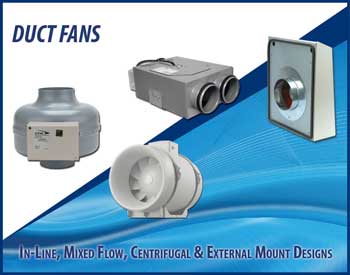
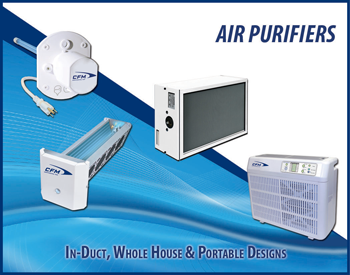
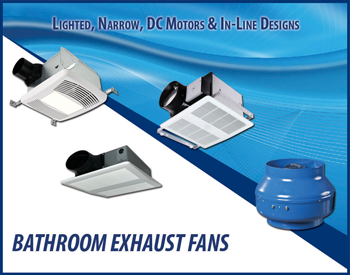
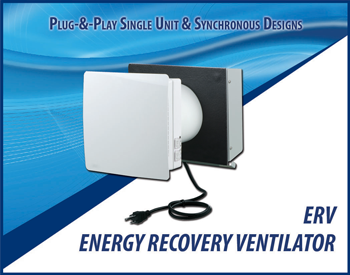
Download a PDF copy of Indoor Air Quality today!


